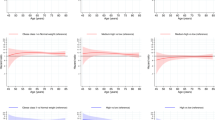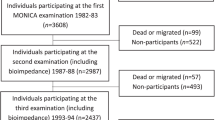Abstract
OBJECTIVE: To re-analyse the previously reported linear relation between Quetelet’s body mass index (BMI) and mortality, among men from the Adventist Mortality Study after accounting for effects due to age at measurement of BMI, smoking history and race.
DESIGN: Prospective cohort study. To specifically account for effects due to age at measurement of BMI, smoking history and race, our methodology includes: 1, computing hazard ratios for BMI quintiles from a proportional hazard regression, with ‘time on study’ as the time variable, and age at baseline as a covariate; 2, conducting separate analyses of middle-aged (age 30–54 y) and older (age 55–74 y) men; and 3, restriction of the analyses to never-smoking, non-Hispanic white males.
SUBJECTS: 5062 men (age: 30–74 y, BMI: 14–44 kg/m2) from the Adventist Mortality Study.
MEASUREMENTS: Subjects reported data on anthropometric, demographic, medical, dietary and lifestyle characteristics at baseline and were enrolled in mortality surveillance during a 26 y study period (1960–1985).
RESULTS: During the early years of follow-up (years 1–8, 9–14), we found some evidence of excess risk among the leanest men that was probably due to the effects of antecedent illness. During the later years of follow-up (years 15–26), effects due to antecedent illness were not apparent and a significant positive, linear relation between BMI and all-cause mortality was consistently found among middle-aged (30–54 y) and older (55–74 y) men. Disease-specific analyses of the later follow-up (years 15–26) revealed that the positive linear trends with all-cause mortality, were primarily due to excess risk of cardiovascular disease and cancer among the heavier men. Among older men, a significant inverse relation between BMI and respiratory disease mortality risk was identified during later follow-up (years 15–26), but this effect attenuated after restriction of the analyses to men with no baseline history of respiratory disease.
CONCLUSIONS: The re-analysis confirms the findings of a positive, linear relation between BMI and all-cause mortality, reported in the original study.
This is a preview of subscription content, access via your institution
Access options
Subscribe to this journal
Receive 12 print issues and online access
$259.00 per year
only $21.58 per issue
Buy this article
- Purchase on Springer Link
- Instant access to full article PDF
Prices may be subject to local taxes which are calculated during checkout
Similar content being viewed by others
Author information
Authors and Affiliations
Rights and permissions
About this article
Cite this article
Lindsted, K., Singh, P. Body mass and 26 y risk of mortality among men who never smoked: a re-analysis among men from the Adventist Mortality Study. Int J Obes 22, 544–548 (1998). https://doi.org/10.1038/sj.ijo.0800623
Received:
Revised:
Accepted:
Published:
Issue Date:
DOI: https://doi.org/10.1038/sj.ijo.0800623
Keywords
This article is cited by
-
Effect of Weight Loss in Adults on Estimation of Risk Due to Adiposity in a Cohort Study
Obesity (2012)
-
Body Mass Index is Inversely Related to Mortality in Elderly Subjects
Journal of General Internal Medicine (2008)
-
Adipositas und Krebs
Der Gynäkologe (2006)
-
Body Fat and Fat-Free Mass and All-Cause Mortality
Obesity Research (2004)
-
Obesity and cancer
Oncogene (2004)



